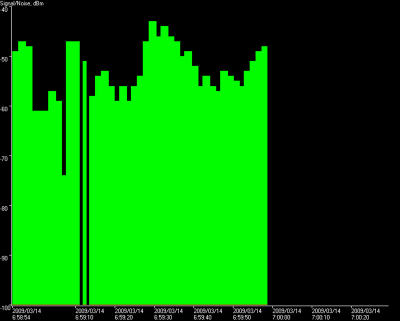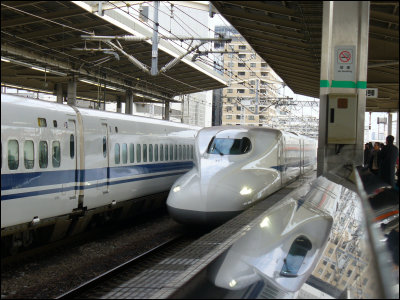Since Internet became available on wireless LAN in Shinkansen so I tried it immediately ~ Radio intensity strength edition ~

Supplies from communication companies started todayWireless LAN service between Tokyo and Shin Osaka on N 700 series ShinkansenHowever, I tried checking on which cars I could comfortably use wireless LAN to communicate.
Persons who are worried that the seats scheduled to sit by themselves will be "out of the service area" because they measure the radio field intensity for each vehicle and each connected part of the vehicle and the vehicle It is a must-see.
Details are as follows.
As a result of checking the radio field intensity for each minute for each vehicle, vehicle-to-vehicle linking part, the following graph was obtained. The higher the numerical value (dBm) on the vertical axis, the better the sensitivity, and the more flat the graph, the more stable the communication is realized.
In each graph, the radio wave intensity of the access point with the best radio condition in that vehicle is adopted.
No.1 car. It is mostly lower than -50 dBm, and radio wave condition is not stable a little.

The connecting part between No. 1 car and No. 2 car. It is less than -50 dBm like car 1, but relatively stable communication is possible.

Car 2 is sluggish. It often breaks down to -60 dBm, and in some cases it can fall to -70 dBm.

The connecting part between No. 2 car and No. 3 car. Impression that it is somewhat more stable than the inside of car 2.

No.3 car. Although it exceeds -40 dBm at the highest value, the fluctuation is intense, such as falling to about -60 dBm at once.

The connecting part between No. 3 car and No. 4 car. The radio field strength is not high, but it is relatively stable.

No. 4 car. Frequently it reaches up to about -40 dBm, the intensity of radio waves is high.

The connecting part between No. 4 and No. 5 cars. It has moved between -50 dBm and -60 dBm.

No. 5 car. It occasionally arrives at -40 dBm.

The connecting part between No. 5 and No. 6 cars. Impression that radio field strength is stable.

No. 6 car. Changes in the graph are becoming extremely intense.

The connecting part between No. 6 car and No. 7 car. The radio field intensity is high and stable.

No. 7 car. It is a very good feeling.

The connecting part between car No. 7 and car No. 8. It ranged between -50 dBm and -60 dBm.

Radio field intensity of No. 8 car (green car) also increased.

The connecting part between No. 8 car and No. 9 car. It is very stable.

The No. 9 car (green car) is on average about -50 dBm.

The intersection of No. 9 car and No. 10 car is extremely graphic.

Car 10 (green car) also roughly roughly reaches -50 dBm.

The connecting part between No. 10 car and No. 11 car. It has moved between -50 dBm and -60 dBm.

No. 11 car. It is on the order of -50 dBm.

The connecting part between No. 11 car and No. 12 car. It has been changing between -40 dBm and -50 dBm, and it is quite good.

No. 12. Although the fluctuation is intense, the maximum value is about -40 dBm.

The connecting part between No. 12 car and No. 13 car. Trends between -50 dBm and -60 dBm.

No. 13 car. It is very stable.

The connecting part between No. 13 car and No. 14 car. The radio field strength is not high as about -60 dBm.

Number 14 car. Trends between -50 dBm and -60 dBm.

The connecting part between No. 14 car and No. 15 car. It has shifted between -50 dBm and -60 dBm, but the fluctuation is intense.

No. 15 car. The result is unprecedented strongly that it changes between -30 dBm and -40 dBm.

The connecting part between No. 15 car and No. 16 car. Trends between -50 dBm and -60 dBm.

Number 16 car. In addition to being stable, radio field intensity is also increased.

Although we actually walked around the entire interior of the car actually measured the radio field strength, the radio wave conditions of No. 7, No. 8, No. 13, No. 15 and No. 16 cars were good, and No. 2 car received a low profile impression.
Although there are places where the radio field intensity is low, it is very wonderful not to be "out of the service area". By the way, as a background to such variations, it is thought that the degree of congestion varies depending on the vehicle and the number of users using the wireless LAN at the same time also influences.
In addition, when I got in touch with the public relations office of JR Tokai, I heard that wireless LAN access points are not allocated to each vehicle one by one, but a plurality of access points are arranged so that they can communicate anywhere.
· Continued
I started to use the N 700 series Shinkansen so I tried it immediately ~ Upward and downward simultaneous use speed report edition ~ - GIGAZINE
Related Posts:
in Review, Coverage, Mobile, Web Service, Posted by darkhorse_log







